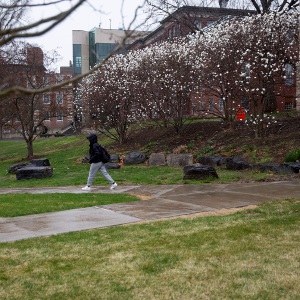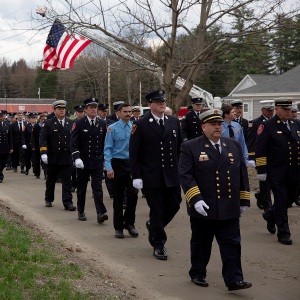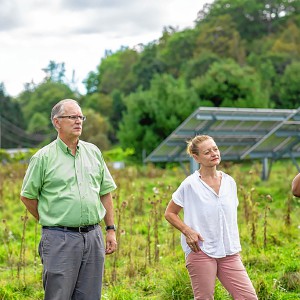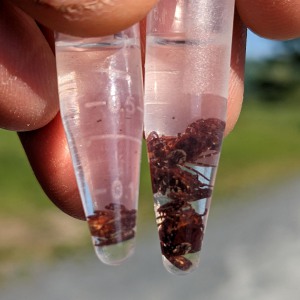Tropical Storm Irene, 10 years later: Sudden flooding overwhelmed Woodstock mobile home park
| Published: 08-28-2021 9:27 PM |
In the late summer days following Tropical Storm Irene’s rampage through Riverside Mobile Home Park in Woodstock, Nelson Gilman and Al Pristaw loaded donated orange juice, bread and carefully placed cartons of eggs into a wheelbarrow.
The two longtime Riverside residents, both in their late 60s at the time, pushed the makeshift food cart through soupy mud that was so thick in places that people put down planks in their yards to reach their doors.
As Gilman and Pristaw made their rounds, the wheelbarrow’s load lightened.
“It was for anybody who needed it, and that was just about everybody,” Gilman told me.
After Irene, Riverside, which has three dozen or so homes, had no drinking water. Its septic system stopped working. Five days passed before electricity was restored.
Debris, ranging from uprooted trees to lawn furniture, was strewn from one end of the 21-acre park to the other. A car, its rear wheels several feet off the ground, stuck out of a deep hole created by Irene’s rushing waters. Homes had been knocked off their cinderblock perches, and 120-gallon propane tanks were tipped over in the mud.
“It looked like a war zone,” said Pristaw, who found a barbecue grill, car tires and garden tools buried in the mud and silt underneath his home. None of it belonged to him.
Riverside, as its name implies, skirts the banks of the Ottauquechee River, a couple miles west of the village and a world away from the white-glove Woodstock that billionaire Laurance Rockefeller built in his image.
Article continues after...
Yesterday's Most Read Articles
 Zantop daughter: ‘I wish James' family the best and hope that they are able to heal’
Zantop daughter: ‘I wish James' family the best and hope that they are able to heal’
 Crowd turns out to honor late Ascutney Fire Chief Darrin Spaulding
Crowd turns out to honor late Ascutney Fire Chief Darrin Spaulding
 A Life: For Kevin Jones ‘everything was geared toward helping other people succeed’
A Life: For Kevin Jones ‘everything was geared toward helping other people succeed’
 Pick a sport and Pete DePalo’s has probably officiated it over the past 40-plus years
Pick a sport and Pete DePalo’s has probably officiated it over the past 40-plus years
 Out & About: Vermont Center for Ecostudies continues Backyard Tick Project
Out & About: Vermont Center for Ecostudies continues Backyard Tick Project
“We’re the last remnants of Woodstock’s working class,” said the 77-year-old Gilman, who made a living over the years as a mechanic, furnace technician and truck driver.
Consisting mostly of retirees living on fixed incomes and working-class families, Riverside residents own their homes but rent their lots (currently about $460 a month) from Housing Foundation Inc., a Montpelier-based nonprofit that operates mobile home parks throughout Vermont. Riverside, which started out as a family-owned mobile home park, dates back to at least the early 1970s,
From Route 4, which runs along a ridge on the opposite side of the Ottauquechee, Riverside’s homes are only faintly visible through the trees.
Out of sight, out of mind.
Which I suspect has long been the preference of Woodstock’s blend of old money and nouveau riche weekenders.
Then came Irene.
“Tin City,” as outsiders sometimes disparagingly call Riverside, showed its mettle.
On Aug. 28, 2011, a Sunday, the rain from Tropical Storm Irene fell fast and steady in central and southern Vermont. Amounts ranged from 4 to 8 inches in less than 18 hours, the National Weather Service reported.
Around noontime, “it was just a downpour,” recalled Everett Chamberlin, Riverside’s park manager. “There was a white sheet of rain, like it was snowing.”
Chamberlin, who has lived in the park since 1987, wasn’t at home. Chamberlin, who works for Woodstock’s highway department, had been called out to unplug culverts in other parts of town, but “there was way too much water to do anything about it,” he said.
With water pouring in from hillside streams, the Ottaquechee swelled with each passing hour. Still, Riverside residents didn’t necessarily see themselves in harm’s way.
Gilman and his wife, Joyce, spent the morning on their enclosed porch, cutting up cucumbers for canning pickles.
After finishing, Nelson turned on the TV while Joyce played cards with a neighbor at the kitchen table. Two kettles of cucumbers and brine — pickles in the making — simmered on the stove.
Looking out the Gilmans’ living room window, the neighbor remarked, “Will you look at that?”
The Ottauquchee, which normally wasn’t visible from the Gilmans’ place, was in full view. Nelson ventured outdoors in the pelting rain to join a few other residents who had also become concerned about the rapidly rising waters.
Some had lived at Riverside long enough to know the Ottauquechee wasn’t always as placid as it appeared from Route 4. But they hadn’t seen the river jumping its banks like this before.
Gilman hurried home.
“To hell with this,” he told his wife. “We’re getting out of here.”
“I can’t leave,” Joyce responded. “We’re making pickles.”
The couple reached a quick compromise: Joyce packed up the kettles to bring with her.
“All I grabbed was my diabetes medicine, test equipment and a couple of pillows,” Nelson said.
Why pillows? “I have no idea.”
Before starting his Dodge Ram pickup, Nelson handed Joyce one of the two walkie-talkies that he kept in the truck. After placing the kettles on the back seat, Joyce got behind the wheel of her Chrysler Sebring.
“Follow me,” Nelson told her.
After taking the only road that leads out of the park, they headed for Royalton, where one of their daughters lived near Dairy Hill. But outside of Woodstock, on a flat stretch before Pomfret’s elementary school, the road was already flooded.
Nelson’s pickup made it through. The rushing water, however, pushed Joyce’s car toward the pavement’s edge.
“I can’t steer,” she radioed her husband.
The 8-year-old car’s engine stalled. “What do I do?” she asked.
“Get out,” he said.
Joyce, who is only 5 feet tall, waded through water up to her waist to reach her husband, who had started walking toward her.
When Nelson returned the next day, the car was a total loss. In the back seat, however, one kettle of pickles had survived.
In another part of Riverside that Sunday, Steve Frost, a carpenter, worked frantically to save the motorcycle he kept in his shed. “I couldn’t move it,” he said. “There was too much water flowing through the shed.”
Before he knew it, the river was swirling all around him. “I got trapped” in the park, said Frost, now 66 and retired.
With water up to his thighs and using a long stick off his woodpile for balance, Frost trudged to the park’s entrance, where rescue workers from neighboring Hartford were helping people to higher ground. Someone tossed Frost a rope.
“I was the last one out,” he said.
Although some residents lost their homes and many more had valuable possessions swept away or damaged, I think most people agree that Irene could have taken an even higher toll at Riverside.
“I’m glad it came in the daylight,” said Sue Esty, a retired Walmart employee who, as I wrote after the storm, escaped Irene’s floodwaters with a bag of clothes in one hand and her Siamese cat, Baby, in the other.
If the flash flooding had occurred during the night when people were asleep, Pristaw is convinced “there would have been deaths. We never could have gathered ourselves in time.”
In Barnard, Laurel and Erik Tobiason didn’t experience Irene’s wrath. But when they heard about severe flooding in Woodstock, they knew Riverside could be in trouble.
Laurel grew up in a working-class family not far from the park. When Irene hit, she’d been working at Woodstock Union High School for more than 25 years, assisting with its horticulture and forestry programs.
She knew kids who lived at Riverside. Other residents, including Chamberlin, the park manager, were among her former students.
“There’s always been a stigma attached to the people who live there,” she said. Outsiders often fail to recognize the “park has a real sense of community,” she added.
The Tobiasons joined Riverside’s lengthy cleanup effort. Erik, a building contractor, brought in his tractor with a bucket loader. “There was a lot of mud and silt from the river, but the worst part was the debris,” he said.
The Housing Foundation hired Dale Snader, owner of Dale’s Homes in White River Junction, to assess the damage and oversee the cleanup. He counted 10 homes beyond repair. After the waters receded, mold became the new enemy.
Snader and his crew spent five months clearing debris, rebuilding roads and improving homeowners’ lots to reduce the risk of future flooding.
It was rewarding work, Snader told me in a December 2011 interview. “When we started putting things back together, people got hope,” he said.
Still, remaining positive wasn’t always easy.
Few residents carried flood insurance, and if they did, it usually wasn’t enough to cover major repairs. Financial assistance from the Federal Emergency Management Agency, better known as FEMA, also proved insufficient, or in some cases nonexistent.
“Wealthy people have insurance and hire people,” said Erik Tobiason. “Most people in Riverside have no financial means to get help.”
Sustainable Woodstock, a nonprofit that administered the area’s flood relief fund, provided money to pay for building materials to repair damaged homes. Volunteers from Habitat for Humanity did some of the work.
University of Vermont students arrived by bus from Burlington to assist with the cleanup. Troops of Boy Scouts came was well. Alison Clarkson, who represents Woodstock in the state Legislature, stepped up the effort to haul water and food into the park after Pristaw sent her an S.O.S. email.
“People came out of nowhere to help,” Pristaw said.
In the cleanup’s early stages there were rumblings that state officials wanted to shutter the park. They didn’t consider it worth saving.
I don’t doubt that some business people viewed the park’s sorry state as an opportunity. In their minds — and pocketbooks — 20 acres of riverfront property in tony Woodstock could be put to better use than an aging mobile home park.
Some Riverside homeowners also questioned whether the park had a future. They’d barely survived Irene. What if another storm hit?
The state has shored up the river’s steepest banks with crushed rocks to protect the park from the likes of another Irene.
But during heavy rains, Esty, now 81, still finds herself paying closer attention to the Ottauquechee’s ebbs and flows than before. “If the water is up a bit, I start to worry,” she said.
Some people have moved out. Others considered leaving, but decided they couldn’t afford it.
“We were one of them,” Nelson Gilman said.
The Gilmans’ home suffered water damage in the kitchen. Mud seeped into a few places. Their porch and shed needed replacing.
But they started adding up what it would cost to move the home, which was already getting on in years, to their daughter’s property in Royalton. They’d need a well, a septic system and a concrete pad for the home. They were looking at about $50,000.
“There’s no way we had that kind of money,” Nelson said.
They built a new porch and replaced the shed that he uses as a workshop. When I stopped by a few weeks ago, Nelson was working on two recently acquired lawn mowers that he planned to fix up.
“I don’t care how old it is or how bad of shape it’s in, he can make anything run,” said Joyce Gilman, who turned 84 earlier this month.
Her husband mows lawns in the park and in the winter clears neighbors’ driveways with his snowblower for extra income.
In their small backyard, the Gilmans grow beets, beans and other vegetables in new raised beds that Nelson built this spring.
“As trailer parks go, it’s a nice, quiet spot,” he said.
Ten years after Irene, only two of Riverside’s 40 lots remain empty.
In a corner of the park, a path leads to the river’s gravel edge. A tall oak, its leaves still green, has uprooted and crashed into the water. The slender tree sprawls from one bank nearly to the other.
But this short stretch of the Ottaquechee remains steadfast, its waters running over, under and around whatever is in its path.
Jim Kenyon can be reached at jkenyon@vnews.com.

 Former principal of South Royalton School released from prison
Former principal of South Royalton School released from prison Upper Valley residents among advocates for NH aid-in-dying bill
Upper Valley residents among advocates for NH aid-in-dying bill 
